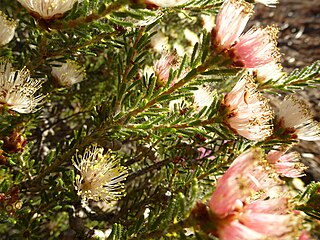
La pasión desnuda is a 1953 Argentine film. It was written and directed by Luis César Amadori and starred María Félix, Carlos Thompson and Eduardo Cuitiño.
Gregory F. Comella is a former professional American football fullback in the National Football League.

Glaucopsyche alexis, the green-underside blue, is a butterfly of the family Lycaenidae. It is found in the Palearctic.
La quintrala is a 1955 Argentine drama film directed by Hugo del Carril. It won the Silver Condor Award for Best Film.

Acronicta laetifica, the pleasant dagger moth, is a species of moth in the family Noctuidae. The species was first described by John Bernhardt Smith in 1897. It is found in North America from Nova Scotia to Florida, west to Texas, north to Manitoba.

Melaleuca laetifica is a plant in the myrtle family, Myrtaceae and is endemic to the west coast of Western Australia. It has unusual warty, hairy leaves and heads of bright yellow flowers in spring. It is one of the brightest yellow flowering melaleucas and deserves a place in gardens in semi-dry to temperate areas.
Comella is a genus of moths of the family Callidulidae.
Heteropsis laetifica is a butterfly in the family Nymphalidae. It is found on Madagascar. Their habitat consists of forests.

Esmeralda is a genus of beetles in the family Cerambycidae, containing the following species: Species of the genus Esmeralda are found in the Guianas and Brazil.

Anastrangalia is a genus of beetle in the family Cerambycidae, containing the following species:
Anastrangalia laetifica is a species of beetle from family Cerambycidae found in Canada, United States, and Mexico. The males are all black, while the females have 4 black dots on their red coloured elytra. They feed on Frasera albicaulis.
Stenolis is a genus of beetles in the family Cerambycidae, containing the following species:
Acrolophus laetifica is a moth of the family Acrolophidae. It is found in South America.

Quinnia laetifica is a species of extremely small deep water sea snail, a marine gastropod mollusk in the family Seguenziidae.
Félix de Azúa Comella is a Spanish professor of aesthetics and philosophy, poet, novelist, essayist and translator, member of Real Academia Española.
Cosmopterix laetifica is a moth in the family Cosmopterigidae. It was described by Edward Meyrick in 1909. It is found in India.
Stenolis laetifica is a species of beetle in the family Cerambycidae. It was described by Henry Walter Bates in 1872.
Oberea laetifica is a species of beetle in the family Cerambycidae. It was described by Francis Polkinghorne Pascoe in 1867.
Cucullia laetifica is a species of moth in the family Noctuidae. It is found in North America.

Zygaena olivieri is a species of moth in the Zygaenidae family. It is found in Syria, Armenia and Georgia. Seitz describes it -In olivieri Boisd. (7h) not only the collar and 2—8 abdominal segments are red but also the patagia, the red spots of the forewing being very large; from Syria and Armenia.In subspecies Z. o. laetifica Herrich-Schäffer, 1846 the pairs of spots on forewing are separate. — In Z. o. ganimedes Freyer, [1851] from Amasia, the penultimate pair of spots and the apical patch are rather broadly connected and the red markings of the forewing have a white edge of about 1 mm width.







